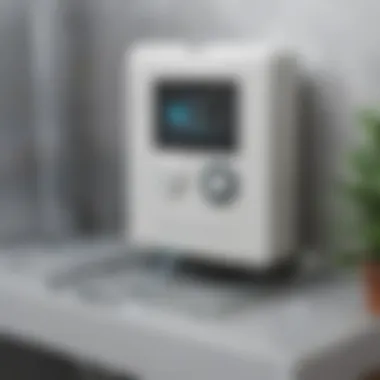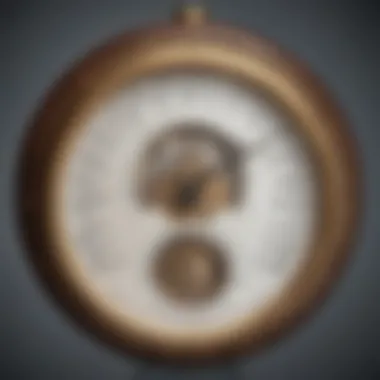Exploring Advanced Tools for Measuring Humidity Levels


Science Fun Facts
Humidity measurement tools are essential devices used to quantify the amount of moisture in the air. Did you know that the concept of measuring humidity dates back centuries, with ancient civilizations finding innovative ways to assess moisture levels?
Discover the Wonders of Science
Measuring humidity plays a crucial role in various fields such as meteorology, agriculture, and manufacturing. Did you know that improper humidity levels can impact both the health of individuals and the performance of certain products? Exploring these tools sheds light on the importance of maintaining optimal humidity conditions.
Science Quiz Time
Are you ready to test your knowledge on humidity measurement tools? What type of humidity sensor is commonly used in weather stations? A) Hygrometer B) Psychrometer C) Barometer D) Anemometer. Dive into these intriguing questions to deepen your understanding of this fundamental scientific concept.
Science Experiment Showcase
Engage in an exciting experiment to create your homemade hygrometer using materials like a cotton thread and a glass jar. Follow the step-by-step instructions carefully to observe how humidity impacts the thread's length. Remember, always prioritize safety by involving adult supervision and handling materials with caution.
Introduction
Defining Humidity
Understanding the concept of humidity
In the realm of humidity measurement, understanding the concept of humidity is paramount. Humidity refers to the amount of water vapor present in the air, influencing various aspects such as temperature regulation and moisture content. This understanding is crucial for maintaining optimal conditions in residential, commercial, and industrial settings. By grasping the concept of humidity, individuals can effectively manage indoor environments and enhance overall comfort levels.
Importance of humidity measurement
The importance of humidity measurement cannot be overstated. Accurate humidity levels are vital for preserving perishable goods, ensuring the efficiency of HVAC systems, and preventing mold growth. By measuring humidity accurately, industries such as agriculture, pharmaceuticals, and food production can maintain quality standards and regulatory compliance. Understanding the significance of humidity measurement empowers individuals and businesses to make informed decisions regarding environmental control and product storage.
Purpose of Humidity Measurement
Why measuring humidity is crucial
Measuring humidity is crucial due to its direct impact on human health, material integrity, and thermal comfort. Understanding and controlling humidity levels can prevent issues like corrosion, bacterial growth, and discomfort. By accurately measuring humidity, individuals can create healthier living spaces and prolong the lifespan of materials and equipment.


Applications across different industries
The applications of humidity measurement span across various industries, including agriculture, meteorology, and manufacturing. In agriculture, humidity measurement informs irrigation practices and plant health assessments. Meteorologists rely on humidity data to forecast weather patterns accurately. In manufacturing processes, controlling humidity levels is essential for product quality and employee well-being. These diverse applications showcase the relevance and versatility of humidity measurement tools in different fields.
Overview of Humidity Measurement Tools
Traditional hygrometers
Traditional hygrometers, such as psychrometers and hair hygrometers, have long been used to measure humidity levels. Psychrometers operate on the principles of temperature and moisture evaporation, offering reliable measurements in various environments. On the other hand, hair hygrometers use the expansion and contraction of human or animal hair to indicate humidity levels. While traditional hygrometers provide accurate readings, they may require manual calibration and have limitations in extreme conditions.
Modern electronic sensors
In contrast, modern electronic sensors, particularly capacitive and resistive sensors, offer advanced capabilities for humidity measurement. Capacitive sensors utilize changes in electrical capacitance to determine humidity levels with precision and speed. These sensors are widely utilized in industrial and scientific applications for their efficiency and accuracy. On the other hand, resistive sensors, employing resistive elements to measure humidity, find applications in industries requiring humidity monitoring in harsh environments. The advent of modern electronic sensors has revolutionized humidity measurement, providing real-time data and remote monitoring capabilities.
Traditional Hygrometers
In the realm of humidity measurement tools, traditional hygrometers hold a significant position. These devices play a crucial role in assessing the moisture content in the air, providing essential data for various applications. Traditional hygrometers have been utilized for decades and offer a reliable method of measuring humidity levels.
Psychrometers
Principles of Operation
Exploring the principles of operation of psychrometers sheds light on their functionality. Psychrometers operate based on the concept of evaporative cooling, where the cooling effect of moisture evaporation is used to calculate relative humidity. This method is widely favored due to its simplicity and accuracy in determining humidity levels.
Types and Variations
Diving into the types and variations of psychrometers showcases the diverse options available. From sling psychrometers to digital psychrometers, each variation offers unique features and benefits catering to specific needs. Understanding these variations helps in selecting the most suitable psychrometer for precise humidity measurement.
Hair Hygrometers
Mechanism of Measurement
The mechanism of measurement employed by hair hygrometers involves the hygroscopic nature of human or animal hair. As humidity levels fluctuate, the hair expands or contracts, allowing for the calculation of relative humidity. This straightforward yet effective method is valued for its accuracy and simplicity in humidity measurement.


Accuracy and Limitations
Delving into the accuracy and limitations of hair hygrometers provides insight into their reliability. While hair hygrometers offer precise humidity readings, they are susceptible to factors like temperature variations and calibration drift over time. Understanding these limitations is crucial for ensuring consistent and accurate humidity measurements.
Modern Electronic Sensors
In the realm of humidity measurement, the emergence of modern electronic sensors signifies a significant leap forward in accuracy and efficiency. These sensors, employing cutting-edge technology, play a pivotal role in various industries where precise humidity control is imperative. At the core of this section lies a detailed exploration of modern electronic sensors, shedding light on their capabilities and advantages over traditional methods.
Capacitive Sensors
Technology Overview
Delving into the intricacies of capacitive sensors reveals a sophisticated technology designed to capture even the minutest changes in humidity levels. The key characteristic of capacitive sensors lies in their ability to measure humidity by detecting changes in capacitance. This unique feature enables them to offer precise and real-time readings, making them a popular choice for applications requiring high accuracy.
Advantages over Traditional Methods
Comparing capacitive sensors to traditional hygrometers underscores the superior advantages they bring to the table. The key characteristic that sets capacitive sensors apart is their ability to provide instant measurements with minimal maintenance requirements. This feature is highly beneficial, especially in industries where quick response times and continuous monitoring are essential. While capacitive sensors may have higher initial costs, their long-term reliability and accuracy make them a cost-effective choice for humidity measurement applications.
Resistive Sensors
Working Principles
The fundamental working principle of resistive sensors revolves around the change in electrical resistance due to varying humidity levels. This key characteristic allows resistive sensors to offer a reliable and stable humidity measurement solution across a wide range of environments. Their simplicity and durability make them a popular choice for applications where robustness is paramount. Despite their straightforward operation, resistive sensors excel in providing consistent and accurate humidity readings, making them a valuable asset in humidity measurement.
Applications in Various Industries
Exploring the applications of resistive sensors unveils their versatility in catering to diverse industry needs. The key characteristic that makes resistive sensors invaluable is their compatibility with different sectors, including agriculture, pharmaceuticals, and food processing. Their ability to withstand harsh environmental conditions and offer reliable performance makes them a preferred choice for industries requiring continuous monitoring of humidity levels. By understanding the unique features and benefits of resistive sensors, industries can enhance their humidity control processes and optimize their operational efficiency.
Calibration and Maintenance
Calibration and maintenance play a crucial role in ensuring the accuracy and reliability of humidity measurement tools. Calibration involves adjusting the device to a standard reference to minimize errors and discrepancies in readings. It is essential to calibrate humidity measurement tools regularly to guarantee precise results. By calibrating the equipment, users can trust the data obtained, leading to informed decision-making based on accurate humidity levels. Maintenance, on the other hand, involves routine care and upkeep of the instruments to prolong their lifespan and performance.
Ensuring Accuracy


Importance of Calibration
Calibration serves as the cornerstone of accurate humidity measurement. The process of calibration aligns the device's readings with the true humidity levels, ensuring consistency and reliability. Effective calibration enhances the trustworthiness of the data obtained, which is critical in various industries such as pharmaceuticals, food processing, and meteorology. By calibrating regularly, users can detect and rectify any deviations, guaranteeing precise results in all circumstances.
Frequency of Calibration
The frequency of calibration is a vital aspect of maintaining accurate humidity measurement tools. Depending on the device's stability and environmental conditions, the calibration interval may vary. For instruments used in critical applications where precision is paramount, frequent calibration is necessary to uphold accuracy. Regular calibration schedules ensure that the tools perform optimally, delivering reliable humidity readings consistently. It is advisable to adhere to manufacturer recommendations regarding calibration frequency to ensure optimal functionality.
Maintenance Tips
Cleaning Procedures
Proper cleaning procedures are essential to uphold the accuracy and longevity of humidity measurement instruments. Dust, dirt, and residues can accumulate on sensors, affecting their performance. Regular cleaning with mild solutions or specialized cleaning kits helps remove contaminants, preserving the sensors' sensitivity and accuracy. Implementing appropriate cleaning techniques ensures that the devices operate efficiently and provide precise humidity measurements.
Storage Recommendations
Appropriate storage practices are crucial in maintaining the integrity of humidity measurement tools when not in use. Storing instruments in clean, dry environments away from direct sunlight and extreme temperatures prevents damage and deterioration. Proper storage reduces the risk of calibration drift and ensures that the devices are ready for use whenever needed. Following recommended storage guidelines for specific instruments enhances their durability and accuracy over time.
Conclusion
Future Trends
Advancements in humidity sensing technology
In the realm of Advancements in humidity sensing technology, a key development is the integration of wireless connectivity. This aspect allows for real-time data transmission to monitoring systems, enhancing efficiency in humidity control processes. The notable characteristic of this advancement is its seamless integration with Internet of Things (Io T) applications, enabling remote monitoring and control. The unique feature of wireless connectivity offers advantages in enhancing accessibility to humidity data and streamlining maintenance routines.
Potential developments on the horizon
Discussing Potential developments on the horizon, miniaturization of sensors is a significant trend. This advancement contributes to space-saving solutions without compromising accuracy. The key characteristic of miniaturized sensors is their versatility in fitting into compact spaces while delivering precise humidity measurements. The unique feature lies in their adaptability across various industries, catering to diverse humidity monitoring needs efficiently.
Final Thoughts
Reflecting on the importance of accurate humidity measurement
Reflecting on the importance of accurate humidity measurement, the emphasis is on the impact of precise data on productivity and product quality. Accurate humidity measurements are crucial for preserving perishable goods in storage facilities and enhancing manufacturing processes. The key characteristic is the direct correlation between precise humidity levels and operational efficiency. The unique feature of accurate measurement tools is their ability to optimize conditions for different applications efficiently.
Encouraging further exploration in the field
Encouraging further exploration in the field is essential for continual advancements in humidity measurement technology. By fostering research and innovation, new possibilities emerge for improving measurement accuracy and expanding application areas. The key characteristic lies in the innovation-driven nature of exploring new frontiers in humidity measurement. Advantages include staying abreast of cutting-edge technologies and contributing to the evolution of humidity sensing capabilities.







